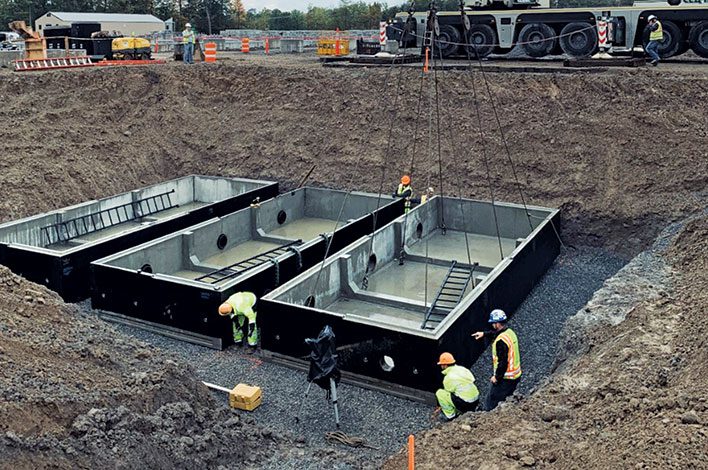Connecting Multiple Precast Tanks Presents Unique Challenges
Committees have been a strong foundation for NPCA’s growth since their inception, addressing major issues head-on and responding to challenges and opportunities through spirited collaboration for the betterment of the entire precast industry.
The work of committee volunteers often culminates in new resources for precasters to utilize in their manufacturing process or share with specifiers, installers and other key stakeholders.
So, when members of the Wastewater Products Committee noticed that the use of multiple precast concrete tanks in close proximity was becoming more prevalent in water, stormwater, wastewater treatment and other utility applications, they decided to develop a guide to highlight the specific issues and applications unique to connecting multiple precast tanks.
“The committee felt that the practice of connecting multiple tanks together was something that has been done for decades in our industry but was becoming even more common,” said Andy Winkler, chair of the Wastewater Products Committee and general manager at Wieser Concrete Products. “The concept was to come up with suggested procedures to ensure that members were correctly connecting them with engineered connections, proper placement, coatings, piping, excavation, testing, buoyancy and backfill requirements.”
The result of the committee’s work, “Best Practices for Connecting Multiple Precast Tanks,” is available on the Septic Tanks page at precast.org. It provides guidance on material selection, manufacturing techniques, site layout, testing and installation and related component recommendations to attain a structurally sound, watertight and durable precast concrete multiple precast tank installation.
“Our goal was for any and all members to utilize this guideline to accomplish connecting multiple tanks with tanks they currently produce,” Winkler said.
7 BEST PRACTICES
- Impacts of Multiple Tanks Configuration
Layout of tanks in series or parallel is usually dependent on the application and site limitations. Walls may adjoin or there may be a space in between, with lifting, pipe connections and backfill taken into consideration. - Lifting Considerations
Devices or lifting points will be installed during tank manufacturing. Lift points outside the tank could be challenging in tight spacing between tanks. When design allows, lifting inserts or other accessories should be placed inside or in the top of the tanks. - Pipe Connections
It is essential to select the right types of connectors, which create continuous watertight seals and protect the surrounding soil and groundwater. Location and accessibility must be considered, as well as whether single component flexible connectors or modular compression seal type connectors are necessary. Connector material also is a factor. - Proper Backfill
Designers should allow a recommended minimum of 36 inches of space between tanks to allow for proper backfilling. Flowable fill is a good option to use between tanks to fill the gaps with smaller separation distances. - Buoyancy Considerations
Soil reports and water table level fluctuations should be considered by designers, who are advised to take a conservative approach if the information in unavailable. Using additional weight of the soil by adding a shelf, increasing the weight of the structure and adding exterior “Shear Keys” can be used to counteract a buoyancy challenge. - Venting
Depending on the purpose of the multiple tanks, vents may need to installed, especially when sanitary, stormwater or potable water will be flowing. Venting relieves any pressure that builds. - Tank & Connector Testing Methods
Some projects may require testing tanks and connections for watertightness. This can be done through vacuum or hydrostatic testing.
REAL-WORLD EXAMPLE
These best practices show tangible benefits in practical application.
Scott Robinson, an installer with Minnesota-based Terra Firma, had a system that required the connection of two tanks to achieve 8,000 gallons. Access at the site inhibited setting one large tank, so the installer connected two 4,000-gallon tanks, with piping at the bottom. It was a dosing/pumping situation and, with the piping at the bottom, they were able to effectively dose from an 8,000-gallon “container.”
The tanks were set at predetermined grades so that the pipe penetrations aligned.
“We placed bedding up to the penetrations to ensure that the pipe was well supported,” Robinson said. “Wieser provided rubber Cast-A-Seal pipe boots at the penetrations.”
Terra Firma installed the tanks and piping, then tested the connection by filling the tank with water.
“We ensured the depth of the water was maintained for 24 hours, similar to the test we do on single holding tanks,” Robinson said. “This being successful left us with surety that we effectively had one 8,000-gallon tank. We were able to calculate our gallons-per-inch and apply that to our dosing requirements.”
GET THE MANUAL AND MORE
The complete “Best Practices for Connecting Multiple Precast Tanks” is available for download at precast.org/septictanks/. It is intended to be a companion to an additional NPCA resource, “Best Practices Manual – On-Site Wastewater Systems,” also available at precast.org.
Both provide valuable insights into attaining structurally sound, watertight and durable precast concrete tank installation.
